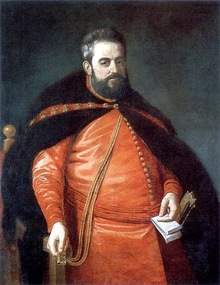Adam Kazanowski
| Adam Kazanowski | |
|---|---|
 | |
| Coat of arms | Grzymała |
| Wife | Elżbieta Słuszczanka |
| Noble family | Kazanowski |
| Father | Zygmunt Kazanowski |
| Mother | Elżbieta Humnicka |
| Born |
1599 Poland |
| Died | 1649 |

Adam Kazanowski (1599–1649) was a noble of the Polish-Lithuanian Commonwealth from 1633. Greater Crown Stolnik from 1634, Court Chamberlain (podkomorzy koronny) and castellan of Sandomierz from 1637, Court Marshall from 1643, żupnik of Wieliczka from 1642, starosta barcicki, borysowski, kozienicki, rumieński, solecki, nowotarski, warecki, bielski. Friend of king Władysław IV Waza. In 1634 married Elżbieta Słuszczanka (later Hieronimowa Radziejowska, when she married Hieronim Radziejowski), but he never had children.
Together with his brother, Stanisław Kazanowski (starost of Krosno, Jaworów and Przedbor), Adam was raised with crown prince Władysław. He accompanied him during his attempt to become a Russian Tzar, in the Chocim war of 1621 and the 1620s European voyage. In 1631 he is the starost if Barcko. When Władysław became king in 1634, he was showered with gifts and new official titles. In 1634 he became the starost of Borysowo, and gained the rank of podstoli and soon after that, stolnik.
Kazanowski was viewed by many as a greedy, arrogant magnate and a 'bad influence' on the king, but he always remained close to Władysław. When Władysław's royal treasury ran dry once, Adam Kazanowski loaned him his money and mortgaged many of his goods, saying My liege, I cannot become poor when I am near to you, but I will not be rich without you. This friendship gave him enough political leverage to remain an important player in the Commonwealth's politics. Privy to the king's thoughts and secrets, and organiser of many lavish parties and festivities, he was not interested in the 'great (foreign) politics', but he was a powerful player in the smaller court intrigues. He knew many secrets of the royal court, and could influence Władysław to be friendly or not towards various newcomers, envoys and other visitors to the court.
As a sign of friendship, Władysław bestowed many favours, positions and gifts to Kazanowski, who soon had his own palace in Warsaw, the richest in Poland, and owned close to half of the Praga district in the capital. A contemporary writer, after his death, wrote: Never has Poland seen so much wealth in a private hand of a single man. Those many favours, especially coupled with both Kazanowski and Władysław lavish spending, raised many protests from the Commonwealth's parliament, the Sejm. They had, however, little effect on both Kazanowski and Władysław.
His influence did diminish after 1637, when Władysław married Habsburg Archduchess Cecilia Renata of Austria. After that, Kazanowski became an enemy of the queen and other Habsburg supporters, like Jerzy Ossoliński, and allied himself with Piotr Gembicki (chancellor until 1642).
Kazanowski died in 1649 and was buried in St. John's Cathedral in Warsaw.[1]
See also
| Wikimedia Commons has media related to Adam Kazanowski. |
References
External links
- (Polish) internautica.pl Portrait of Adam Kazanowski in red żupan by Peter Danckerts de Rij (display at Wawel Castle)
| |||||
|